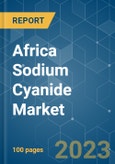COVID-19 moderately impacted industry growth due to many countries' supply chain disruptions and lockdowns. However, the surging mining industry in South Africa and Ghana, among others, is likely to increase sodium cyanide consumption.
Key Highlights
- The primary factor driving the studied market growth is the increasing demand for gold mining activities.
- Conversely, sodium cyanide toxicity is expected to hinder the studied market's growth.
- The discovery of new mines is expected to offer new growth opportunities to the market studied.
- South Africa dominated the market studied owing to its surging application in the mining industry.
Sodium Cyanide Market Trends
Increasing Demand from Mining Industry
- A significant portion of the sodium cyanide produced worldwide is used in mining and metallurgy, especially in extracting gold and silver. It is one of the most economically viable, easily processable, and environmentally sustainable technologies for processing gold.
- Typically, gold is extracted from its ore using sodium cyanide through leeching. In this process, the ore is crushed into a fine powder using industrial machinery. Then, the dust is added to a sodium cyanide (NaCN) solution and processed.
- During the process, the gold molecules form strong bonds with the NaCN and become water-soluble. Applying zinc separates the cyanide molecules from the gold and turns the gold back into a solid, preparing it for the smelting process.
- Africa includes abundant mineral sources, making it a hub for the global mining industry. Apart from South Africa, a significant mining industry, the countries like Ghana, Mali, and Burkina Faso, also include rapidly growing mining industries.
- Africa is a major producer of many essential mineral commodities, with bountiful reserves of metals and minerals such as gold, diamond, cobalt, bauxite, iron ore, coal, and copper across the continent.
- West Africa is a prime spot for gold exploration. It attracted significant investments from companies worldwide in the past few years, owing to the largely untouched mineral reserves present in the region. There is a significant growth in the gold assets in West Africa, with around 367 assets in the exploration stage, 24 assets under economic assessment, and 61 assets in the production or construction stage.
- The total gold mine production in Africa amounted to 680.3 metric tons in 2021, an increase of roughly 0.5% compared to the previous year.
- From 2010 onward, there was an increase in gold production, which reached approximately 3,000 metric tons in 2022. More than 21 countries in Africa, the third-largest producer of gold in the world, are involved in gold mining. Ghana, the second-largest supplier of gold in Africa and one of the world's top producers, generated about 90 metric tons of gold in 2022.
- The application of sodium cyanide in mining and metallurgy is expected to increase during the forecast period.
South Africa to Dominate the Market
- South Africa is incredibly rich in natural resources, with large reserves of some of the most valuable minerals on the planet below its surface. The mining industry became hugely important to the country.
- South Africa produces over 250 million tons of coal every year. It is estimated that almost 75% of this coal is used domestically. Nearly 80% of the energy needs of South Africa are taken care of by coal, and over 90% of the coal consumed on the entire African continent is produced in South Africa.
- Additionally, coal production in South Africa amounted to 5.55 exajoules in 2021, down by nearly 5% from the previous year.
- South Africa was the world's leading gold producer until 2007. However, production declined significantly from that time onward due to the stagnation of the country's mining industry. In 2022, approximately 110 metric tons of gold were produced in South Africa.
- Some of the major gold mines in the country include the South Deep gold mine, the Kromdraai gold mine, the Mponeng gold mine, the East Rand gold mine, and the Tautona gold mine, among others.
- The South African chemical industry is an upstream sector for the country's mining and agricultural sectors. It is also one of the major chemical industries in Africa. As the country includes significant raw material sources, an increase in foreign investment may create significant growth opportunities in the country's chemical sector in the future.
- According to the Chemical and Allied Industries Association, the chemicals industry is a crucial sector of the South African economy. It accounts for about 25% of the nation's manufacturing sales.
- The Chemicals business of Sasol is South Africa's sole manufacturer of sodium cyanide solution, which is sold to the local gold mining industry to extract and elute gold. In South Africa, Sasol Polymers Sasolburg operates Sodium Cyanide Production Plants 1 and 2, which are recertified in full compliance with the International Cyanide Management Code (Cyanide Code).
- Therefore, the factors above are expected to boost sodium cyanide consumption in mining and chemical sectors across South Africa.
Sodium Cyanide Industry Overview
The sodium cyanide market in Africa is majorly consolidated, with the top four players accounting for a significant share in production capacities. Major players in the market include TAEKWANG INDUSTRIAL CO., LTD, TSPC, Sasol, Orica Limited, and Australian Gold Reagents Pty Ltd, among others (not in any particular order).Additional Benefits:
- The market estimate (ME) sheet in Excel format
- 3 months of analyst support
This product will be delivered within 2 business days.
Table of Contents
Companies Mentioned (Partial List)
A selection of companies mentioned in this report includes, but is not limited to:
- Australian Gold Reagents Pty Ltd
- Evonik Industries AG
- HeBei ChengXin
- Honeywell International Inc.
- Orica Limited
- Sasol
- TAEKWANG INDUSTRIAL CO., LTD
- TSPC
- The Chemours Company








